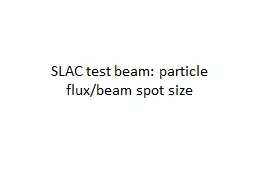

Tuning the beam from Andys slides SLAC can provide and you can control between single electrons 200 electrons per bunch as its output 5 bunches a second 5Hz Beam size between 30 microns and 1cm ID: 786324
Download The PPT/PDF document "SLAC test beam: particle flux/beam spot ..." is the property of its rightful owner. Permission is granted to download and print the materials on this web site for personal, non-commercial use only, and to display it on your personal computer provided you do not modify the materials and that you retain all copyright notices contained in the materials. By downloading content from our website, you accept the terms of this agreement.
Slide1
SLAC test beam: particle flux/beam spot size
Slide2Tuning the beam (from Andy’s slides)
SLAC can provide (and you can control)
between single electrons – 200 electrons per bunch as its output
5 bunches a second (5Hz)
Beam size between 30 microns and 1cm
2
How many events to we want/need?
In pixels with improvement to analysis code we can get results with ~200k events
Slide3FCF requirements
FCF block can read out up to 4 hits (clusters) per ASIC, the rest is discarded
First ones that arrive are read out?
The same particles must be read out on both sides of the doublet
Does not like hits on consecutive strips coming from 2 different particles (confuses them as a cluster created by a single particle)
Requires some separation between hits (low occupancy) in order to perform correlation
Only the axial strips of the sensors are bonded to ASICs
Slide4Proposed flux/beam spot size
If we use
10e/bunch
and
1 cm
2
beam spot
Low probability of double hits (~0.45%, check table at the end)
Will get enough data in reasonable time scale
Is this OK for the ABCN (covering all the sensor, around 10% occupancy per bunch)?
For the FCF:
1cm
2
~ 128 strips on 1 row, up to 256 on 2 rows
~ 0.1 hits per strip and per bunch
Low probability of consecutive strip hits per bunch
Still 10 hits/bunch, but can be distributed between consecutive ASICs and
unbonded
strip rows to lower the rate of hits/chip
Slide5FCF examples
Bonded
Bonded
Unbonded
Chip 1
Chip 2
Chip 1
Chip 2
Chip 1
Chip 2
Chip 1
Chip 2
Chip 1
Chip 2
~10e/chip
~
5e/chip
~2.5e/chip
~5e/chip
~5e/chip
10e/bunch
and
1 cm
2
beam spot
Beam spot size, chip size and strips length approx. to scale
In most cases we should be OK
Alignment may be a bit more tricky
For relative displacement between sensors, use
(b)
or
(c)
(a)
(b)
(d)
(c)
(e)
Slide6Total number of events
For the ABCN
10 events * 5 bunches per second = 3000 per minute
200,000/3000= 67 minutes per run
Reasonable time scale for 200k events
For the FCF we will get 50% or 25% of that (I think it is still ok)
Slide7Double hit probability
What is the probability that 1 of the 100 strips will be hit by 2 electrons from 10 e/bunch
Translate into bins and balls..
What is the probability that any bin will contain more an 1 ball after 10 balls are thrown?
Slide8Maths
How many bins have r balls?
Probability that a given bin has r balls is
=
For
m,n
>> r,
m = no of balls
n = no of bins
R = no of balls in 1 bin (
eg
1, 2
etc
Slide9Results
Number of Balls
Prob
of a bin having
1 ball
Prob of a bin having 2 balls
Prob of a bin having 3 balls
1
0.99%
0.00%
0.00%
5
4.76%
0.12%
0.00%
10
9.05%
0.45%
0.02%
15
12.91%
0.97%
0.05%
20
16.37%
1.64%
0.11%
25
19.47%
2.43%
0.20%
30
22.22%
3.33%
0.33%
35
24.66%
4.32%
0.50%
40
26.81%
5.36%
0.72%
45
28.69%
6.46%
0.97%
50
30.33%
7.58%
1.26%
55
31.73%
8.73%
1.60%
60
32.93%
9.88%
1.98%
65
33.93%
11.03%
2.39%
70
34.76%
12.17%
2.84%
75
35.43%
13.29%
3.32%
80
35.95%
14.38%
3.83%
85
36.33%
15.44%
4.37%
90
36.59%
16.47%
4.94%
95
36.74%
17.45%
5.53%
100
36.79%
18.39%
6.13%